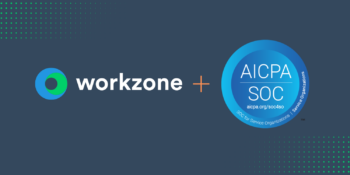Process Management in Project Management and Business Process Management (BPM) are similar concepts. BPM deals with managing and organizing business processes, and so does project management. BPM affects all levels of an organization, and that includes Project Managers, especially when you consider project management processes.
After all, there are 49 unique processes defined within the Project Management Book of Knowledge (PMBOK). Executing all of these processes properly and at the right time can become extremely difficult without a strong organization methodology in place.
Organizing processes allows you to understand how these 49 processes interrelate with each other and with other processes within your business. The result of organization is a unified framework, which makes it easier for you to plan and manage the timeline of your project.
6 Steps to Process Management in Project Management
There are six main steps you should follow to organize business or project processes.
1. Consider your project
Your project deliverable, scope, and business purpose can all affect how you organize your processes and work.
For example, if your project is for software development, it’s very likely that you will opt for an Agile methodology to project management. This will result in you organizing your project and processes very differently than if you were using a Prince2 methodology.
2. Identify processes and activities
The next step is to identify the project processes, activities, and tasks needed to complete your project successfully.
It’s important to consider the entire scope of your project. If you are responsible for after-delivery support, such as end-user training, you need to include those processes in your project plan as well.
3. Classify and group processes
Once all of your processes, activities, and tasks are identified, it’s time to group them together.
Grouping processes is the most complex organizational step, and there is a wealth of literature around different approaches that can be used. There are three primary approaches to consider, which we will discuss in the next section.
4. Assign work and delegate authority
After you’ve grouped processes together, it’s time to assign them to your project team.
A RACI matrix is often used to clearly assign roles and responsibilities within the team. This simple diagram identifies who is responsible, who is accountable, who needs to be consulted, and who needs to be kept informed for each task or process.
5. Design reporting relationships
After assigning work, identify reporting relationships among the team. Does the entire project team report directly to you? Or do you have assistant project managers, team leads, or other personnel that people will report up to?
When deciding reporting relationships, it’s important to consider the size of your project team and the ideal span of control. The ideal span can be anywhere from 3-15 people per reporting authority.
The ideal number depends on several factors:
- The structure of your project
- The complexity of your project
- The skillset and approach of the authority figures
- The expertise of your team
6. Manage coordination
Once your project structure is complete, it’s important to oversee it and ensure that it is working effectively. A key aspect that you will need to monitor as the project manager is the coordination between different groups.
For example, imagine that you have a design team reporting to a design lead, who reports to you. Imagine that you also have a testing team, reporting to a test coordinator, who reports to you. In this scenario, you will need to make sure the two separate teams are keeping each other informed and working together as well as updating you.
3 Options for Grouping Processes and Activities
1. The work process approach
The work process approach aligns processes based on their outcomes. This is the simplest and most common approach to grouping project processes.
In this approach, you start by grouping processes into one of two buckets: operational processes and administrative processes.
‘Manage quality’ would be an operational process, while ‘plan quality management’ would be an administrative process.
2. The behavioral process approach
The behavioral process approach aligns processes based on behavior patterns.
According to David Garvin of the Harvard Business School, “Behavioral processes are the sequences of steps used for accomplishing the cognitive and interpersonal aspects of work.”
It can be challenging to group processes in this way, as behaviors can vary from person to person, project to project, and organization to organization.
However, these processes tend to fall into three sub-categories:
- Decision-making processes, such as ‘plan risk responses.’
- Communication processes, such as ‘manage communications.’
- Organizational learning processes. The ‘lessons learned’ process, which is part of the ‘close project or phase’ process, is a great example of this.
3. The change process approach
The change process approach aligns processes based on changes in the project, product, or organizational life cycle.
In this approach, you start by grouping processes under either autonomous processes or induced processes.
Autonomous processes are changes that occur naturally. Induced processes are ones that much be triggered by an action or event.
An autonomous process could be ‘validate scope,’ as it naturally becomes necessary during certain phases of a project. For example, during the software development life cycle (SDLC), you would need to validate scope in the implementation stage but should not have to do so once you move through to the maintenance stage.
An example of an induced process is ‘implement risk response.’ This process does not come into effect unless it is triggered by a risk occurring.
Other considerations for organizing processes
When you’re determining how to group and assign processes and activities, there are four more considerations that you should take into account. These are:
- Whether the process is repetitive and ongoing or a one-time requirement.
- If the process needs more than one person or type of resource to complete it.
- What the dependencies are between processes.
- Processes that are heavily dependent on each other should be grouped together.
- How your organization typically groups processes and project activities.
- If they generally group processes by phase, and you group by function, it could be difficult for your team to adapt.
Whichever approach you take to organizing processes, it’s important to map out the entire structure, workflow, and reporting relationship. A visual model can help communicate the structure with the team and ensure that no dependencies have been missed.
Summary: Process Management in Project Management
There are six primary steps to organizing your project processes and activities:
- Consider your project needs.
- Identify the processes.
- Classify and group processes.
- Assign work and authority.
- Build the reporting structure.
- Oversee coordination.
When grouping processes together, there are three primary approaches:
- Work process
- Behavioral process
- Change process
Other factors to consider are:
- Repetitive vs. single processes
- Solo vs. collaborative processes.
- Process dependencies.
- Your business’ normal approach.
Suggested reading:
MITSloan: The Processes of Organization and Management
PMI: Lessons learned taking it to the next level
LinkedIn: What are the Software Development Life Cycle (SDLC) phases?



